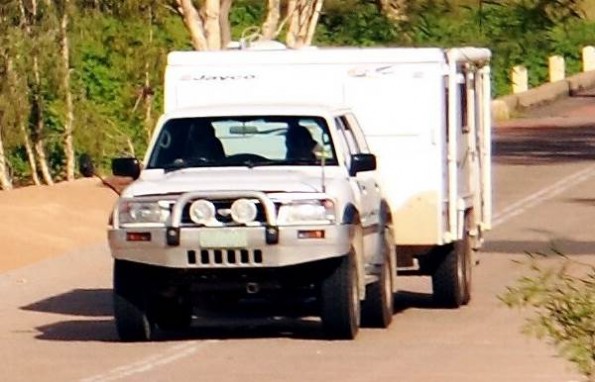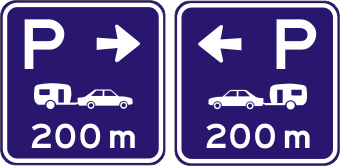
Once you have your P2 or full licence you can tow a caravan, tent trailer or camper trailer. If you have never towed a trailer before, read our definitive guide to towing, here, as it has weights, measures and general advice. A caravan requires some specific towing advice, though.
Caravans are lightweight trailers that contain living quarters. They typically weigh between 600-2500kg. Because they are lightweight and high-sided they are prone to be affected by crosswinds and the turbulence and slipstream from large vehicles.
If you already have a towing vehicle (car, SUV or ute) then you will need to match your caravan to your vehicle’s towing capacity and the type of tow ball or hitch you have fitted. If you are purchasing both a vehicle and a caravan, choose the caravan based on your requirements, then choose a car that’s suitable to tow it. Your car must be capable of towing the maximum weight of the caravan; you will be able to get these figures from your car’s manufacturer. You must not tow a trailer behind your caravan; your car is only allowed to tow one item at a time.
Stick to a practical weight ratio. Even a fairly small car can tow quite a large caravan, but on a windy day or when it is quite hilly, you’ll be glad that you purchased a car that is heavier with a bigger engine. However, many owners won’t want a big, powerful car all the time, so you might want to make a compromise here. If you are planning on caravanning a lot, and heading into the back country, a sturdy diesel 4wd will be the best option.
Towing weight
The caravan manufacturer will be able to supply the weight of the caravan (it should be on a plate somewhere near the door), and then you’ll need to add on the weight of any items you are carrying in it (the ‘user payload’) to ensure that you don’t exceed the rated load on your tow ball or for your towing vehicle. Allow 120-150kg for basic items for two people, but if you want to carry a lot of specific heavy items, particularly things like spare gas bottles, this can bump the weight up further. It might be better to carry some items in your car instead. If you want to load heavy items in your caravan, put them over the axle, in the middle. Balance other items front and back. You don’t want to have too much weight on the back because it will lift the tow ball which will reduce the rear grip of the car. Ideally you want around 100kg of weight on the tow ball of the car (the noseweight) – this is usually around 5-7% of the total weight of the caravan.
Your caravan plus vehicle must not exceed the maximum permissible weight and your caravan should not exceed the vehicle’s noseweight (this is the limit of weight that the tow ball will take). A cheap way of checking this is a set of study bathroom scales and a block of wood that is approximately the same height as the tow ball is off the ground. Rest the wood on the scales and note its weight, then place the caravan’s tow hitch on the wood and you’ll see the total weight.
Ideally you should only tow a caravan that weighs 85% or less than the kerb weight of your car. Experienced caravan owners that only take their caravans on sealed roads could go to 100% but it is advised by caravan organisations never to exceed the 1:1 ratio.
If the caravan exceeds 750kg the towing vehicle will need it to have its own brakes. Here are the rules:
0-750kg loaded weight: no brakes are required
751-2000kg loaded weight: braking on both wheels on at least one axle
2001-4500kg loaded weight: braking on all wheels and an automatic breakaway system in case the trailer becomes detached from the vehicle.
Brakes must be able to be operated from the driver’s seating position.
The towing limit when set by manufacturers is the weight at which a fully laden towing vehicle can start the vehicle combination (i.e. car plus caravan) five times on an uphill gradient of at least 12% within five minutes.
Driving style
Light, fairly unladen caravans can bounce around a lot on bumpy roads, so it’s best to slow down. All items in the caravan should be secure otherwise they will move around. Cupboard doors and drawers should have latches to stop them coming open. Position any other items low down to keep the centre of gravity low.
Brake earlier for a corner and take corners more slowly. Your caravan will be pushing your car forward as you brake, even if it has its own brakes. On long descents there is a risk of brake fade – reduce your speed early and change down a gear. If you notice your brake pedal feeling spongy and braking performance is reduced you need to stop immediately and let the brakes cool down; you could literally have just seconds before your brakes fade completely.
Because your entire length is longer and (most probably) wider, too, you will need to take corners wider so that you don’t clip a kerb or other items on the side of the road like signs.
Take extra care overtaking cyclists and pedestrians as your vehicle will be wider than usual, and you will create more turbulence.
People are not allowed to ride in a caravan while it is being towed because caravans have minimal crash protection.
It will take you longer to overtake other vehicles because your acceleration will be slower and your combined length is longer.
You will use more fuel. If you are calculating whether you have enough fuel left while you are travelling through an area with scant fuel resources, make sure to err on the safe side. Carry a reserve tank, fill up when you can, and expect that your fuel economy could be 50% worse than with normal driving.
Don’t hold other traffic up unnecessarily – move over and let other drivers past.
There is no specific speed restriction in NSW while towing a trailer, but you must not exceed the speed limit. In slippery conditions the extra forces acting on your vehicle make it more likely you will skid so drive to the conditions.
If your caravan is over 17ft long and 2000kg then you will need a weight distribution hitch/load equaliser such as a Hayman Reece as it is compulsory. This helps your vehicle maintain weight on the front end, meaning your braking isn’t compromised.
You can get towing practice and education from a company such as Tow-Ed.
Reversing
Reversing requires some practice. We recommend you practice this in a large open space, for example, a large empty car park, before you actually need it for real. As you won’t be able to see around the caravan using your normal side mirrors you will need to fit some wing mirror extenders.
Snaking and pitching
Snaking is where the caravan starts to move from side-to-side in a lateral swaying movement. In extreme cases the caravan will tip over, possibly taking the car with it.
Pitching is where the front of the caravan bounces up and down on the tow ball causing the back end of the car to be pulled around.
Both pitching and snaking can be caused by turbulence and side winds. For both of them, lift off the accelerator, keep a firm grip of the steering wheel and bring it back under control by steering in a straight line. Do not brake – let the car’s engine braking do the work.
Caravan parking
There are sometimes specific areas for parking caravans which will be marked using the signs below.

If not, you can park your caravan anywhere it is not either illegally parked or is causing an obstruction to other vehicles.
Choose a flat area preferably not facing uphill; if you have to move away uphill this increases the chance that you won’t have enough grip to get going and will just wheelspin.
Before you set off, ensure that you have disconnected your caravan from any on-site power outlets, disengaged the handbrake, removed any chocks around the wheels and wound in the legs (corner stabilisers). Double check the hitch and electrical connections, plus the tyres and bodywork. The caravan door should be locked and all windows closed. Empty water tanks and toilet cassette before moving off if possible. Check the lights are working.
Before hitching the caravan (if you’ve left it at some point) chock the wheels, apply the caravan handbrake and wind down the front jockey wheel. Have someone help guide you reversing to the caravan. Put the car handbrake on then release the caravan handbrake fully. Move the coupling over the tow ball and lower the caravan using the jockey wheel.
The final part can be dangerous if you are on a slope, which is why you need to chock the wheels. However, chocked wheels mean that you will find it difficult to move the caravan, therefore you will need to have positioned the car’s tow ball very close to the coupling.
Road conditions
If you are going into the outback be prepared for the kind of conditions that we have – scorching weather, infrequent fuel stops, rough roads, large trucks and road trains, and more. Always let someone know where you are going. If you are going into the middle of nowhere an emergency personal locator beacon is a good safeguard to getting stuck on a road where there might only be one vehicle every couple of days. Take spares and plenty of water.
Vehicle tax and insurance
Trailers and caravans don’t need CTP (Compulsory Third Party) insurance; your towing vehicle will, though. More information about CTP insurance can be found here.
The vehicle tax as of writing is:
| Vehicle type | Tare Weight (kg) | Private Use | Business Use |
| Caravans and trailers |
up to 254 |
$0 |
$95 |
|
255 to 764 |
$107 |
$174 |
|
|
765 to 975 |
$195 |
$316 |
|
|
976 to 1154 |
$221 |
$355 |
|
|
1155 to 1504 |
$255 |
$414 |
|
| 1505 to 2504 |
$389 |
$624 |
